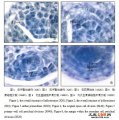黄花蒿小孢子的发生和雄配子体的形成
来源:wenku163.com 资料编号:WK1637589 资料等级:★★★★★ %E8%B5%84%E6%96%99%E7%BC%96%E5%8F%B7%EF%BC%9AWK1637589
资料介绍
黄花蒿小孢子的发生和雄配子体的形成(10900字)
摘 要:利用常规石蜡切片技术,观察了黄花蒿小孢子发生及雄配子体发育过程。结果表明:(1)花药具4个花粉囊,花药壁发育为单子叶型,由4层细胞构成:表皮、药室内壁、中层和绒毡层,绒毡层属于腺质型;(2)从孢原细胞出现到二细胞花粉粒形成,同一花药四个花粉囊的发育不同步,相差1-2个时期;(3)孢原细胞为单孢原起源;小孢子母细胞减数分裂为连续型,形成的四分体为四面体型排列;(4)成熟花粉粒为二细胞型,四个萌发孔,外壁属于光滑型;(5)小孢子母细胞时期,花药壁中层与绒毡层相继开始解体,且中层的解体速度快于绒毡层。
关键词:黄花蒿;发育;小孢子发生;雄配子体
The Microsporogenesis and the Formation of Male Gametophytes in Artemisia annua
Abstract: The Microsporogenesis and the Formation of Male Gametophytes in Artemisia annua were observed by using method of traditional paraffin sections. The results showed that anther was tetrasporangiate, and the development of anther wall was the monocotyledonous type, which included an epidermis, an endothelium, a middle layer and a tapetum. The tapetum belonged to glandular tpetum. From appearance of archesporial cells to 2-celled pollen stage, the development of tetrasporangiate was asynchronous. They are difference of 1-2 stage. The archesporial cells differentiated from single archesporium, the meiosis of microspore mother cells were continuous type and tetrads were tetrahedral. The mature pollen grains were two-celled with 4 aperture, the extine belonged to psilate. At the MMC stage, middle layer and tapetum began to disintegration, and the middle layer is faster than the tapetum.
Key words: Artemisia annua; development; Microsporogenesis; Male gametophyte
研究目的和意义
人工种植黄花蒿必须把黄花蒿种质资源的调查研究和品种资源建设放在首位。积极培育出优质(含量高)、稳定(性状)、高产的黄花蒿新品种成为当务之急。如何获得黄花蒿性状稳定的纯系对异花授粉的黄花蒿而言,必须强迫其自交才能获得纯系(或自交系),在未有克服黄花蒿自交不亲和的有效方法之前,利用系统选育连续多代单株选择获得性状稳定的优良自交系是有效的育种方法,但获得稳定的纯系,需要7—10年的时间。采用组织培养的个体间基因型、表现型一致,性状稳定,但该类品种都是杂合程度很高的基因型,如果进行有性繁殖,杂种一代就会出现复杂的多样性分离,因此只能使用一代。采用花药单倍体或花粉粒小孢子培养可在3-4年后获得稳定的纯系,但黄花蒿的花特别细小,这也给花药培养处理带来很大困难,因此如果攻克了黄花蒿花药单倍体和小孢子培养技术,则进行黄花蒿花药或小孢子培养是获得纯系的较好途径之一[4]。应用石蜡切片的方法对其小孢子和雄配子体的发生及发育过程进行研究,为黄花蒿自交不亲和机理的探索奠定基础。

目 录
摘要……………………………………………………………………………………1
关键词…………………………………………………………………………………1
1 前言…………………………………………………………………………………2
1.1黄花蒿的研究现状………………………………………………………………2
1.2研究目的和意义…………………………………………………………………3
2 材料、器具与试剂………………………………………………………………4
2.1材料………………………………………………………………………………4
2.2器具与试剂……………………………………………………………………4
3方法…………………………………………………………………………………4
3.1取样与清洗………………………………………………………………………4
3.2脱水及透明………………………………………………………………………4
3.3渗蜡……………………………………………………………………………4
3.4包埋………………………………………………………………………………5
3.5切片、粘片…………………………………………………………………………5
3.5.1切片………………………………………………………………………5
3.5.2粘片………………………………………………………………………5
3.6脱蜡、复水及染色…………………………………………………………………5
3.7脱水、透明及封片…………………………………………………………………6
3.8观察与拍照………………………………………………………………………6
3.9花序直径测量与雄蕊发育观察记录……………………………………………6
4结果与分析…………………………………………………………………………6
4.1花序与雄蕊发育…………………………………………………………………6
4.2小孢子的发生和雄配子体的形成………………………………………………6
4.2.1花药壁的发育……………………………………………………………6
4.2.2小孢子的发生……………………………………………………………8
4.2.3雄配子体的形成…………………………………………………………8
5讨论…………………………………………………………………………………12
参考文献………………………………………………………………………………14
致谢………………………………………………………………………………16
|



